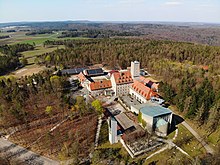Feuerstein Castle
Feuerstein Castle is on the edge of the so-called Long Mile near Ebermannstadt in the Forchheim district . It was built in 1941 by Oskar Vierling as a laboratory for research into high-frequency technology and electroacoustics and was used by 250 employees until 1945 for research on weapons and communication technology as part of the German armaments of World War II .
Confiscated by American soldiers at the end of the war, the castle was leased in 1946 by the Archdiocese of Bamberg under the direction of Jupp Schneider and acquired in 1949. Since then, the castle and the entire area have served as a Catholic youth and meeting place.
history
Oskar Vierling was looking for a centrally located location for his laboratories. The choice fell on the mountain with the field name Feuerstein. The design of a castle corresponded to the image of Franconian Switzerland and was also chosen for camouflage reasons. During the war it was camouflaged as a medical facility (red cross made of bricks on the roof), but the castle actually housed a laboratory for secret armaments projects of the National Socialists . After the end of the war it was abandoned, construction plans and documents were destroyed. However, in 2011 the cryptography historian Norbert Ryska came across a document from the American special unit Ticom ( Target Intelligence Committee ) that describes Vierling's work at Feuerstein Castle in more detail. According to this, Vierling worked on behalf of the Nazis on voice encryption methods, acoustic torpedo guidance, acoustic ignitions of mines, anti-location technology for submarines and in radio and electrical engineering.
Today's wine cellar is a relic from the construction period and used to be a walk-in safe with a ten centimeter thick steel door. The attraction of the castle does not come from a medieval origin, but from the building history in the war and its young age.
The castle was expanded to include bedroom extensions, dining room, leisure facilities (bowling alley, table tennis, volleyball, hard court, sports field), conference rooms, tent sites, agriculture, riding stables, and glider airfield. Today, Feuerstein Castle presents itself as a modern youth center in the diocese of Bamberg.
In 1999 the Feuerstein observatory was founded 500 m south of the Burg Feuerstein airfield . The observatory took its name from the castle. The tower of the castle is used by the observatory as a radio relay station for connection to the town of Ebermannstadt in the valley . In this way, the tower built by Vierling to test the first radio link still fulfills the purpose planned at the time. For this purpose, the Kleine Feuerstein , today's scout house Lindersberg, was built about 1.5 kilometers north of the castle .
The churches
In 1961 the church was consecrated to the Transfiguration of the Lord . It consists of three church rooms, the crypt , the lower church and the upper church. The crypt is accessed by stairs from the lower church and is only sparsely lit. In it are the eternal light and the tabernacle. On the sides of the tabernacle are twelve candlesticks as symbols for the apostles.
The lower church is dedicated to Mary, the “Mother of Wisdom”, there is an altar, behind it is a mural depicting the Lauretanian litany . The glass windows are kept dark and show a predator's head, fire, broken ears and the grim reaper on one side and the human being, a rainbow, the sun and angel wings on the other. Both the mural and the windows are works by the painter Alfred Heller from Bamberg. After leaving the lower church, the path leads past windows that represent the basic attitudes of Christian spirituality : Oratio - Meditatio - Contemplatio.
The upper church was built under the supervision of the architect Heinzmann and the cathedral master builder Skull. It was consecrated in 1961 and structurally anticipated one of the possibilities opened up by the liturgical reform of the Second Vatican Council , which began one year later : the altar is indented into the church so that the priest reads the mass facing the believers. The large glass wall shows the burning bush on the right ( Ex 3.1–6 EU ) and on the left the sacrifice of Elijah ( 1 Kings 18.1–40 EU ). The glass wall is a work by the glass painter Georg Meistermann . The Way of the Cross was designed by young people in 2005.
See also
Web links
Individual evidence
- ^ Nazi Laboratory in Upper Franconia: Secret weapons from the castle dungeon . someday. Contemporary stories on Spiegel Online. Retrieved April 22, 2011.
- ↑ See the Instruction on the Proper Implementation of the Constitution on the Sacred Liturgy " Inter Oecumenici " of September 26, 1964, No. 91.
Coordinates: 49 ° 47 '8 " N , 11 ° 9' 45" E

